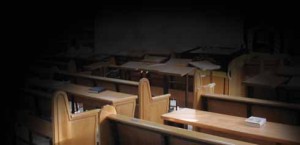Back to the Beit Midrash
On the far left side of the beit midrash, three rows from the back of the room, one seat in at a narrow wooden table, is my makom kavua, my accustomed place to sit.
Once a year.
With few exceptions, I have used some of my vacation time—usually a week or two, sometimes a month or an entire summer—to travel up to Ohr Somayach, a ba’al teshuvah yeshivah in New York State’s Rockland County, for a personal retreat, a period of learning and introspection and spiritual battery charging.
The campus and atmosphere of Ohr Somayach’s Monsey campus are as far removed my work environment as possible.
I work in the hubbub of a Times Square newsroom, across from the noise of a crowded mid-Broadway traffic island, where bands play and “Good Morning America” street-side visitors shout, and from the MTV studio, where throngs of youngsters jostle inside police barricades for a view of the latest guest du jour. Inside our offices: people yelling and computer keyboards clicking.
Every winter, I board a bus in Manhattan that takes me north of the city; I study in a forest. The study hall and dorms of Ohr Somayach are located on the site of a former bungalow colony, in a clearing of woods that stretch a few hundred yards from the highway to an adjoining boy’s yeshivah. There are no stores for a few miles in any direction, no signs of development besides homes and synagogues and other yeshivot. There are no newspapers delivered to the yeshivah, no TVs in the dorms.
Walking in the parking lot, I am as likely to see a deer as an SUV.
No distractions there.
Which is why I go there.
Deep in the news cycle 24/6, I relish this annual break from the headlines, not even opening up a newspaper at the homes of friends who subscribe to the Times or a local publication.
The world has not changed, I always find when I return to New York City and my accustomed reading habits.
Maybe I have changed, if my learning was successful.
Clean-shaven, sans Borsalino, I look “modern,” whatever that means, an anomaly in the black-hat milieu of Ohr Somayach. No one there cares, neither the rabbis nor the talmidim, many of whom I see every year. I’m just another student, someone who turns up uninvited to round up some study partners and tutors in the beit midrash, sometimes to drop in on the occasional class.
In the beit midrash I’m not a reporter; just an older bachur.
During the working year, finding time for steady learning is always difficult. I study regularly by myself at home, arrange a phone chavruta several times a week with a more-advanced friend, but things come up: I have to work late, he has to meet someone. We don’t learn that night, and I feel my skills waning. So I work Ohr Somayach into my schedule again.
My Orthodox friends understand. “Learn well,” are their parting words.
My non-Orthodox friends don’t. “Don’t you already know everything?” they ask. If only. “Don’t come back too Jewish,” others warn, fearing that a week or two of intense learning will turn me into what they consider some type of “ultra-Orthodox” Jew. As if that is so bad.
I love my work. I feel truly blessed and fulfilled fifty weeks a year by writing stories, meeting constant deadlines and doing online research on arcane—often ephemeral—subjects.
For two weeks a year the only deadlines are my own schedule, the only assignments are my interest in some hand-picked aspect of Torah, the only written sources are hundreds or thousands of years old, depending on which text I pull off a library shelf.
Quiet?
Not at all.
The beit midrash of Ohr Somayach, with its high ceiling and wood panels, resembles the reading room of an Ivy League library, but without the “Shhhhh!” of librarians. Learning in a yeshivah means shouting, the high-decibel, high-energy blasts of rabbis and chavrutot. By nature I’m not a shouter, but you quickly learn to assert yourself vocally to be heard above the din.
I’m by no means a talmid chacham. After nearly three decades of struggling with the vowel-less, punctuation-less, truncated language of the Talmud, I still find it a challenge, needing help to make sense of a daf. I feel a bit more comfortable with the Written Law, usually spending my fortnight in the Torah and its countless commentaries.
Ohr Somayach’s beit midrash and classrooms and library shelves have become a second home; I know where to find a certain author in the library, a needed scholar in the study hall.
Now I’m back on the job, looking forward to the next time I take my place on the far left side, three rows from the back, one seat in.
Steve Lipman is a former staff writer for the Jewish Week in New York.

